Spatial Distribution and Source Apportionment of Soil Heavy Metals in Pearl River Delta, China
Abstract
:1. Introduction
2. Materials and Methods
2.1. Study Area
2.2. Soil Sample Treatment and Analysis
2.3. Evaluation of Soil HM Pollution
2.4. PCA-MLR Model
2.5. Data Processing
3. Results and Discussion
3.1. Descriptive Statistics of HMs in PRD
3.2. Evaluation of Soil HM Pollution
3.3. Spatial Distribution Characteristics of Soil HMs
3.4. Source Apportionment of Soil HMs
3.4.1. Pearson Correlation Analysis
3.4.2. Source Apportionment by PCA-MLR Model
4. Conclusions
Supplementary Materials
Author Contributions
Funding
Institutional Review Board Statement
Informed Consent Statement
Data Availability Statement
Conflicts of Interest
References
- Jacob, J.M.; Karthik, C.; Saratale, R.G.; Kumar, S.S.; Prabakar, D.; Kadirvelu, K.; Arivalagan, P. Biological approaches to tackle heavy metal pollution: A survey of literature. J. Environ. Manag. 2018, 217, 56–70. [Google Scholar] [CrossRef]
- Liu, W.; Wang, J.; Zhang, C. Evaluation of soil chemical properties and actinomycete community structure following a temporal sequence of revegetation through Paulownia Fortunei in the heavy metal–contaminated soil. Water Air Soil Pollut. 2013, 224, 1730. [Google Scholar] [CrossRef]
- Negahban, S.; Mokarram, M.; Pourghasemi, H.R.; Zhang, H.C. Ecological risk potential assessment of heavy metal contaminated soils in Ophiolitic formations. Environ. Res. 2021, 192, 110305. [Google Scholar] [CrossRef]
- Yang, Q.; Li, Z.; Lu, X.; Duan, Q.; Huang, L.; Bi, J. A review of soil heavy metal pollution from industrial and agricultural regions in China: Pollution and risk assessment. Sci. Total Environ. 2018, 642, 690–700. [Google Scholar] [CrossRef]
- Buaisha, M.; Balku, S.; Ozalp-Yaman, S. Heavy metal removal investigation in conventional activated sludge systems. Civil Eng. J. 2020, 6, 470–477. [Google Scholar] [CrossRef] [Green Version]
- Vatanpour, N.; Feizy, J.; Talouki, H.H.; Es’haghi, Z.; Scesi, L.; Malvandi, A.M. The high levels of heavy metal accumulation in cultivated rice from the Tajan river basin: Health and ecological risk assessment. Chemosphere 2020, 245, 125639. [Google Scholar] [CrossRef] [PubMed]
- Wu, W.; Wu, P.; Yang, F.; Sun, D.L.; Zhang, D.X.; Zhou, Y.K. Assessment of heavy metal pollution and human health risks in urban soils around an electronics manufacturing facility. Sci. Total Environ. 2018, 630, 53–61. [Google Scholar] [CrossRef] [PubMed]
- Alexakis, D. Human health risk assessment associated with Co, Cr, Mn, Ni and V contents in agricultural soils from a Mediterranean site. Arch. Agron. Soil Sci. 2016, 62, 359–373. [Google Scholar] [CrossRef]
- Zoni, S.; Lucchini, R.G. Manganese exposure: Cognitive, motor and behavioral effects on children: A review of recent findings. Curr. Opin. Pediatr. 2013, 25, 255–260. [Google Scholar] [CrossRef] [Green Version]
- Jiang, J.; Lu, S.; Zhang, H.; Liu, G.; Lin, K.; Huang, W.; Luo, R.; Zhang, X.; Tang, C.; Yu, Y. Dietary intake of human essential elements from a Total Diet Study in Shenzhen, Guangdong Province, China. J. Food Compos. Anal. 2015, 39, 1–7. [Google Scholar] [CrossRef]
- Saeedi, M.; Hosseinzadeh, M.; Jamshidi, A.; Pajooheshfar, S.P. Assessment of heavy metals contamination and leaching characteristics in highway side soils, Iran. Environ. Monit. Assess. 2009, 151, 231–241. [Google Scholar] [CrossRef] [PubMed]
- Obeng-Gyasi, E.; Roostaei, J.; Gibson, J.M. Lead Distribution in urban soil in a medium-sized city: Household scale analysis. Environ. Sci. Technol. 2021, 55, 3696–3705. [Google Scholar] [CrossRef] [PubMed]
- Wang, S.; Cai, L.M.; Wen, H.H.; Luo, J.; Wang, Q.S.; Liu, X. Spatial distribution and source apportionment of heavy metals in soil from a typical county-level city of Guangdong Province, China. Sci. Total Environ. 2019, 655, 92–101. [Google Scholar] [CrossRef] [PubMed]
- Hu, Y.; Liu, X.; Bai, J.; Shih, K.; Zeng, E.Y.; Cheng, H. Assessing heavy metal pollution in the surface soils of a region that had undergone three decades of intense industrialization and urbanization. Environ. Sci. Pollut. Res. 2013, 20, 6150–6159. [Google Scholar] [CrossRef]
- Mazurek, R.; Kowalska, J.; Gasiorek, M.; Zadrozny, P.; Jozefowska, A.; Zaleski, T.; Kepka, W.; Tymczuk, M.; Orlowska, K. Assessment of heavy metals contamination in surface layers of Roztocze National Park forest soils (SE Poland) by indices of pollution. Chemosphere 2017, 168, 839–850. [Google Scholar] [CrossRef]
- Shi, G.L.; Zeng, F.; Li, X.; Feng, Y.C.; Wang, Y.Q.; Liu, G.X.; Zhu, T. Estimated contributions and uncertainties of PCA/MLR-CMB results: Source apportionment for synthetic and ambient datasets. Atmos. Environ. 2011, 45, 2811–2819. [Google Scholar] [CrossRef]
- Li, A.; Jang, J.K.; Scheff, P.A. Application of EPA CMB8.2 model for source apportionment of sediment PAHs in Lake Calumet, Chicago. Environ. Sci. Technol. 2003, 37, 2958–2965. [Google Scholar] [CrossRef]
- Paatero, P.; Tapper, U. Positive matrix factorization: A non-negative factor model with optimal utilization of error estimates of data values. Environmetrics 1994, 5, 111–126. [Google Scholar] [CrossRef]
- Sahu, M.; Hu, S.; Ryan, P.H.; Masters, G.L.; Grinshpun, S.A.; Chow, J.C.; Biswas, P. Chemical compositions and source identification of PM2.5 aerosols for estimation of a diesel source surrogate. Sci. Total Environ. 2011, 409, 2642–2651. [Google Scholar] [CrossRef]
- Salim, I.; Sajjad, R.U.; Paule-Mercado, M.C.; Memon, S.A.; Lee, B.Y.; Sukhbaatar, C.; Lee, C.H. Comparison of two receptor models PCA-MLR and PMF for source identification and apportionment of pollution carried by runoff from catchment and sub-watershed areas with mixed land cover in South Korea. Sci. Total Environ. 2019, 663, 764–775. [Google Scholar] [CrossRef]
- Huang, G.; Sun, J.; Zhang, Y.; Jing, J.; Zhang, Y.; Liu, J. Distribution of Arsenic in Sewage Irrigation Area of Pearl River Delta, China. J. Earth Sci. 2011, 22, 396–410. [Google Scholar] [CrossRef]
- Hou, Q.Y.; Yang, Z.F.; Yu, T.; You, Y.H.; Dou, L.; Li, K. Impacts of parent material on distributions of potentially toxic elements in soils from Pearl River Delta in South China. Sci. Rep. 2020, 10, 17394. [Google Scholar] [CrossRef]
- Lan, H.X.; Hu, R.L.; Yue, Z.Q.; Lee, C.F.; Wang, S.J. Engineering and Geological Characteristics of Granite Weathering Profiles in South China. J. Asian Earth Sci. 2003, 21, 353–364. [Google Scholar] [CrossRef]
- Xiao, Q.; Zong, Y.T.; Lu, S.G. Assessment of heavy metal pollution and human health risk in urban soils of steel industrial city (Anshan), Liaoning, Northeast China. Ecotoxicol. Environ. Saf. 2015, 120, 377–385. [Google Scholar]
- Zhang, S.; Yang, G.; Luo, G.; Guo, S. Changes of Background Values of Inorganic Elements in Soils of Guangdong Province. Soils 2012, 44, 1009–1014. [Google Scholar]
- Iakovides, M.; Iakovides, G.; Stephanou, E.G. Atmospheric particle-bound polycyclic aromatic hydrocarbons, n-alkanes, hopanes, steranes and trace metals: PM2.5 source identification, individual and cumulative multi-pathway lifetime cancer risk assessment in the urban environment. Sci. Total Environ. 2021, 752, 141834. [Google Scholar] [CrossRef]
- Wu, H.; Xu, C.; Wang, J.; Xiang, Y.; Ren, M.; Qie, H.; Zhang, Y.; Yao, R.; Li, L.; Lin, A. Health risk assessment based on source identification of heavy metals: A case study of Beiyun River, China. Ecotoxicol. Environ. Saf. 2021, 213, 112046. [Google Scholar] [CrossRef]
- Soil Environmental Quality-Risk Control Standard for Soil Contamination of Agricultural Land. Available online: http://www.mee.gov.cn/ywgz/fgbz/bz/bzwb/trhj/201807/t20180703_446029.shtml (accessed on 1 August 2018).
- Wang, M.X.; Liang, L.N.; Siu, W.S.; Fan, D.; Sun, H.R.; Zhao, H.H.; Zhou, G.J.; Wu, W.J. Loss accounting of environmental pollution within Pearl River Delta region, South China. Environ. Pollut. 2019, 249, 676–685. [Google Scholar] [CrossRef]
- Ma, L.; Wang, L.; Jia, Y.; Yang, Z. Arsenic speciation in locally grown rice grains from Hunan Province, China: Spatial distribution and potential health risk. Sci. Total Environ. 2016, 557, 438–444. [Google Scholar] [CrossRef]
- Lv, J.; Liu, Y.; Zhang, Z.; Dai, J. Factorial kriging and stepwise regression approach to identify environmental factors influencing spatial multi-scale variability of heavy metals in soils. J. Hazard. Mater. 2013, 261, 387–397. [Google Scholar] [CrossRef]
- Chen, T.Y.; Zhao, H.F.; Wu, K.N.; Zhang, Z.; Jin, Q.; Liu, S.; Li, L.H. Distributional Characteristics and Source Identification of Cadmium in Soils of the Pearl River Delta, China. Bull. Environ. Contam. Toxicol. 2021, 106, 75–85. [Google Scholar] [CrossRef] [PubMed]
- Oral, R.; Pagano, G.; Siciliano, A.; Toscanesi, M.; Gravina, M.; Di Nunzio, A.; Palumbo, A.; Thomas, P.J.; Tommasi, F.; Buric, P.; et al. Soil pollution and toxicity in an area affected by emissions from a bauxite processing plant and a power plant in Gardanne (southern France). Ecotoxicol. Environ. Saf. 2019, 170, 55–61. [Google Scholar] [CrossRef] [PubMed]
- Katsoyiannis, I.A.; Katsoyiannis, A.A. Arsenic and other metal contamination of groundwaters in the industrial area of Thessaloniki, Northern Greece. Environ. Monit. Assess. 2006, 123, 393–406. [Google Scholar] [CrossRef] [PubMed]
- Zhang, H.H.; Yuan, H.X.; Hu, Y.G.; Wu, Z.F.; Zhu, L.A.; Zhu, L.; Li, F.B.; Li, D.Q. Spatial distribution and vertical variation of arsenic in Guangdong soil profiles, China. Environ. Pollut. 2006, 144, 492–499. [Google Scholar] [CrossRef]
- Acosta, J.A.; Martinez-Martinez, S.; Faz, A.; Arocena, J. Accumulations of major and trace elements in particle size fractions of soils on eight different parent materials. Geoderma 2011, 161, 30–42. [Google Scholar] [CrossRef]
- Zhuo, X.Z.; Niu, B.X.; Ju, Y.W.; Zhang, L.Y.; Yan, Q.H.; Yang, J.L. Nanopore Formation and Structural Changes in Black Shale During the Initial Weathering Stage: A Longmaxi Formation Profile in Northwestern Hunan, China. J. Nanosci. Nanotechnol. 2021, 21, 195–211. [Google Scholar] [CrossRef]
- Scopelliti, G.; Russo, V. Petrographic and geochemical characterization of the Middle-Upper Jurassic Fe-Mn crusts and mineralizations from Monte Inici (north-western Sicily): Genetic implications. Int. J. Earth Sci. 2021, 110, 559–582. [Google Scholar] [CrossRef]
- Hernandez, L.; Probst, A.; Probst, J.L.; Ulrich, E. Heavy metal distribution in some French forest soils: Evidence for atmospheric contamination. Sci. Total Environ. 2003, 312, 195–219. [Google Scholar] [CrossRef] [Green Version]
- Avino, P.; Capannesi, G.; Rosada, A. Heavy metal determination in atmospheric particulate matter by instrumental neutron activation analysis. Microchem. J. 2008, 88, 97–106. [Google Scholar] [CrossRef]
- Guo, W.; Zhang, H.; Cui, S.; Xu, Q.; Tang, Z.; Gao, F. Assessment of the distribution and risks of organochlorine pesticides in core sediments from areas of different human activity on Lake Baiyangdian, China. Stoch. Environ. Res. Risk Assess. 2014, 28, 1035–1044. [Google Scholar] [CrossRef]
- Cui, Z.; Wang, Y.; Zhao, N.; Yu, R.; Xu, G.; Yu, Y. Spatial Distribution and Risk Assessment of Heavy Metals in Paddy Soils of Yongshuyu Irrigation Area from Songhua River Basin, Northeast China. Chin. Geogr. Sci. 2018, 28, 797–809. [Google Scholar] [CrossRef] [Green Version]
- Li, H.; Li, Y.; Lee, M.K.; Liu, Z.; Miao, C. Spatiotemporal Analysis of Heavy Metal Water Pollution in Transitional China. Sustainability 2015, 7, 9067–9087. [Google Scholar] [CrossRef] [Green Version]
- Zhang, X.Y.; Lin, F.F.; Wong, M.T.F.; Feng, X.L.; Wang, K. Identification of soil heavy metal sources from anthropogenic activities and pollution assessment of Fuyang County, China. Environ. Monit. Assess. 2009, 154, 439–449. [Google Scholar] [CrossRef] [PubMed]
- Dietrich, M.; Huling, J.; Krekeler, M.P.S. Metal pollution investigation of Goldman Park, Middletown Ohio: Evidence for steel and coal pollution in a high child use setting. Sci. Total Environ. 2018, 618, 1350–1362. [Google Scholar] [CrossRef]
- Sun, X.F.; Zhang, L.X.; Lv, J.S. Spatial assessment models to evaluate human health risk associated to soil potentially toxic elements. Environ. Pollut. 2021, 268, 10. [Google Scholar] [CrossRef] [PubMed]
- Mico, C.; Recatala, L.; Peris, A.; Sanchez, J. Assessing heavy metal sources in agricultural soils of an European Mediterranean area by multivariate analysis. Chemosphere 2006, 65, 863–872. [Google Scholar] [CrossRef]
- Cai, L.; Huang, L.; Zhou, Y.; Xu, Z.; Peng, X.; Yao, L.; Zhou, Y.; Peng, P. Heavy metal concentrations of agricultural soils and vegetables from Dongguan, Guangdong. J. Geog. Sci. 2010, 20, 121–134. [Google Scholar] [CrossRef]
- Hu, Y.; Cheng, H. Application of Stochastic Models in Identification and Apportionment of Heavy Metal Pollution Sources in the Surface Soils of a Large-Scale Region. Environ. Sci. Technol. 2013, 47, 3752–3760. [Google Scholar] [CrossRef] [PubMed]
- Smedley, P.L.; Kinniburgh, D.G. A review of the source, behaviour and distribution of arsenic in natural waters. Appl. Geochem. 2002, 17, 517–568. [Google Scholar] [CrossRef] [Green Version]
- Liang, J.; Hua, S.; Zeng, G.; Yuan, Y.; Lai, X.; Li, X.; Li, F.; Wu, H.; Huang, L.; Yu, X. Application of weight method based on canonical correspondence analysis for assessment of Anatidae habitat suitability: A case study in East Dongting Lake, Middle China. Ecol. Eng. 2015, 77, 119–126. [Google Scholar] [CrossRef]
- Hughes, M.F.; Beck, B.D.; Chen, Y.; Lewis, A.S.; Thomas, D.J. Arsenic Exposure and Toxicology: A Historical Perspective. Toxicol. Sci. 2011, 123, 305–332. [Google Scholar] [CrossRef] [Green Version]
- Hu, Y.; Cheng, H.; Tao, S.; Schnoor, J.L. China’s Ban on Phenylarsonic Feed Additives, A Major Step toward Reducing the Human and Ecosystem Health Risk from Arsenic. Environ. Sci. Technol. 2019, 53, 12177–12187. [Google Scholar] [CrossRef] [PubMed]
- Zhao, W.; Cheng, H.; Taos, S. Structure-Reactivity Relationships in the Adsorption and Degradation of Substituted Phenylarsonic Acids on Birnessite (delta-MnO2). Environ. Sci. Technol. 2020, 54, 1475–1483. [Google Scholar] [CrossRef]
- Hu, Y.; He, K.; Sun, Z.; Chen, G.; Cheng, H. Quantitative source apportionment of heavy metal(loid)s in the agricultural soils of an industrializing region and associated model uncertainty. J. Hazard. Mater. 2020, 391, 122244. [Google Scholar]
- Zhang, X.; Wei, S.; Sun, Q.; Wadood, S.A.; Guo, B. Source identification and spatial distribution of arsenic and heavy metals in agricultural soil around Hunan industrial estate by positive matrix factorization model, principle components analysis and geo statistical analysis. Ecotoxicol. Environ. Saf. 2018, 159, 354–362. [Google Scholar] [CrossRef] [PubMed]
- Soffianian, A.R.; Bakir, H.B.; Khodakarami, L. Evaluation of heavy metals concentration in soil using GIS, RS and Geostatistics. IOSR 2015, 9, 61–75. [Google Scholar]
- Yang, Y.; Christakos, G.; Guo, M.W.; Xiao, L.; Huang, W. Space-time quantitative source apportionment of soil heavy metal concentration increments. Environ. Pollut. 2017, 223, 560–566. [Google Scholar] [CrossRef] [PubMed]
- Larsen, R.K.; Baker, J.E. Source apportionment of polycyclic aromatic hydrocarbons in the urban atmosphere: A comparison of three methods. Environ. Sci. Technol. 2003, 37, 1873–1881. [Google Scholar] [CrossRef] [PubMed]
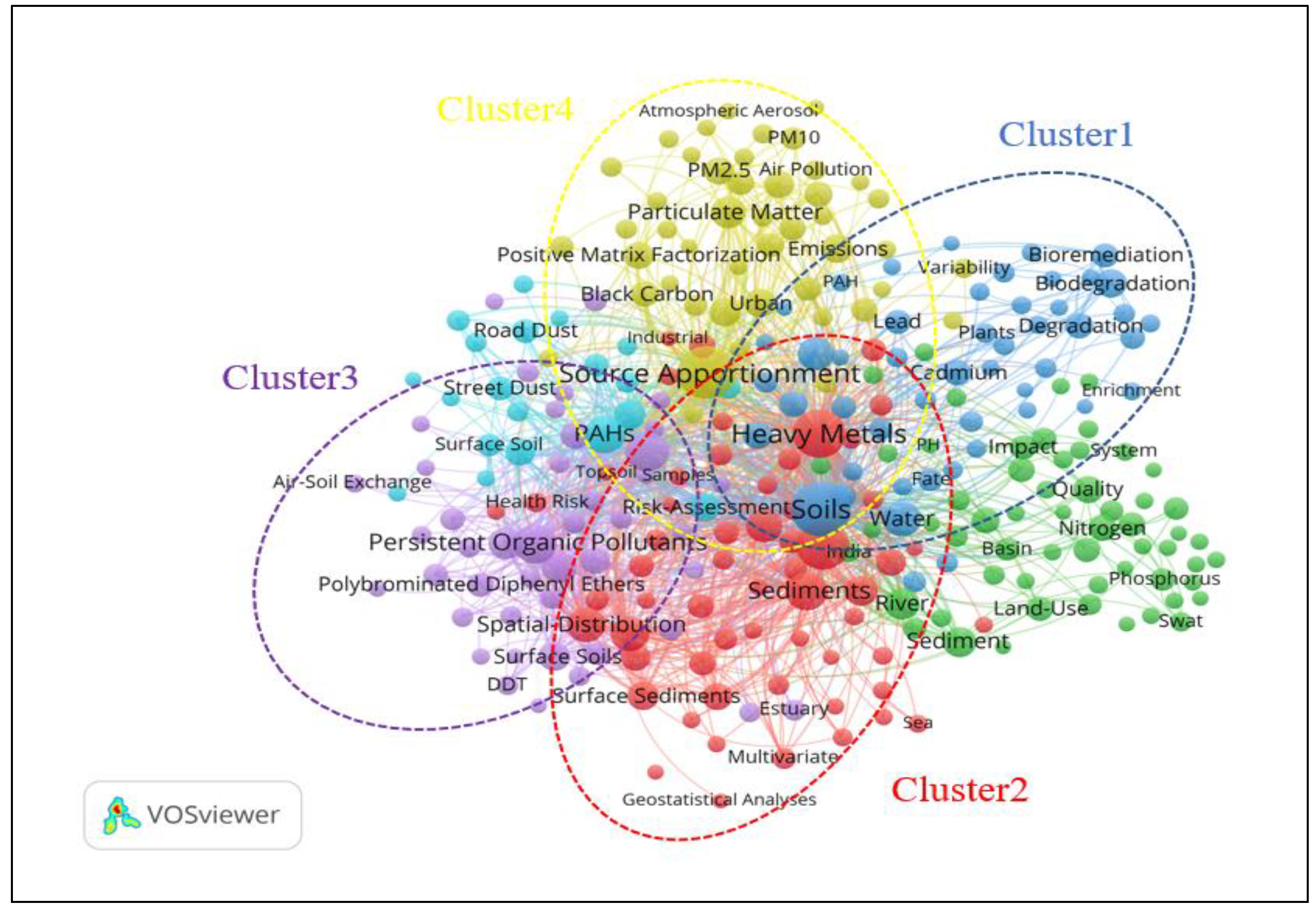

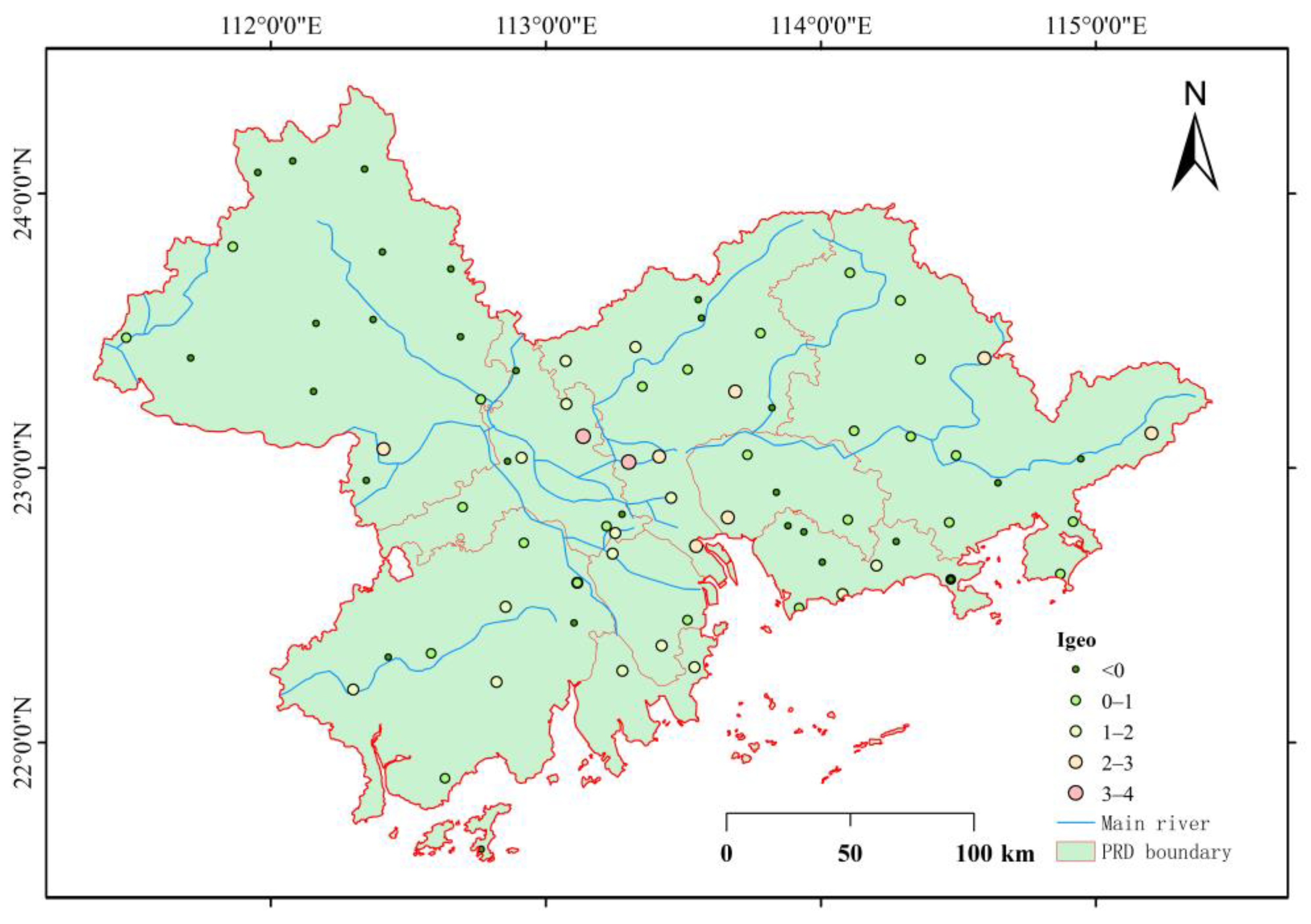
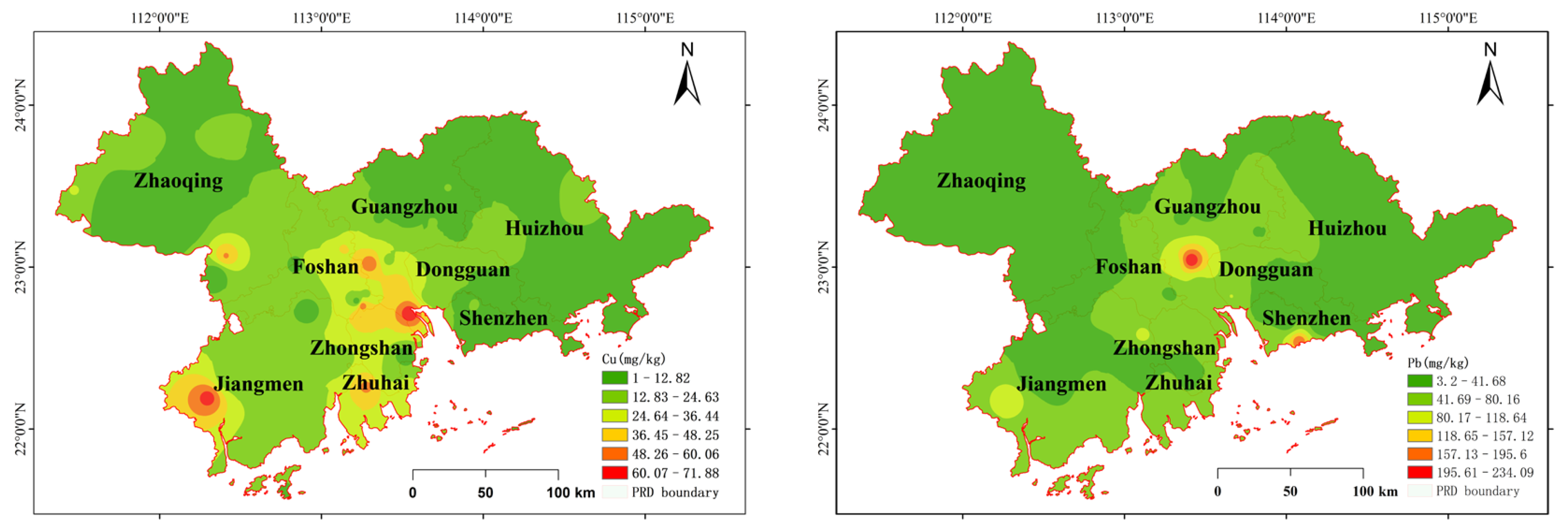

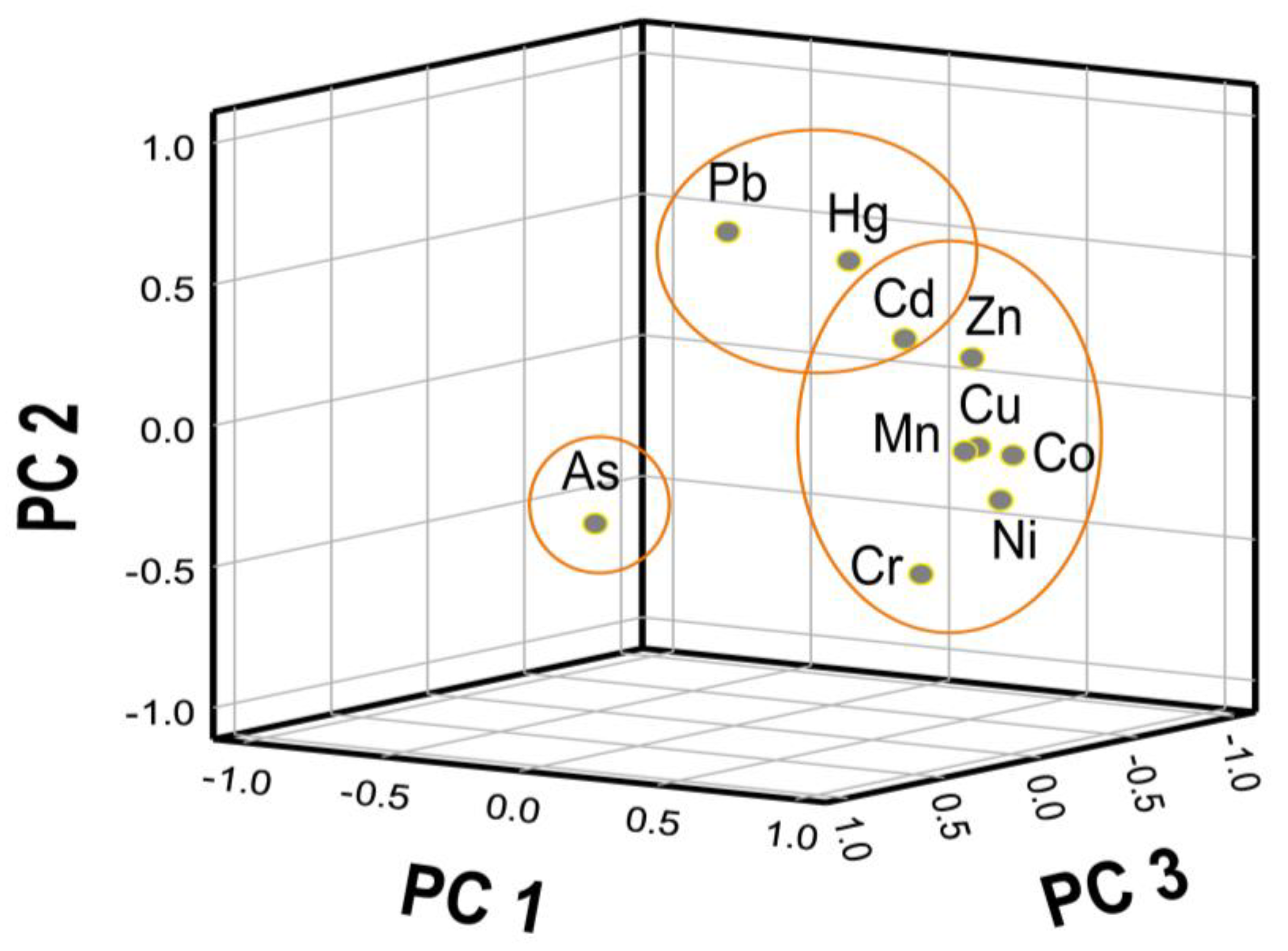

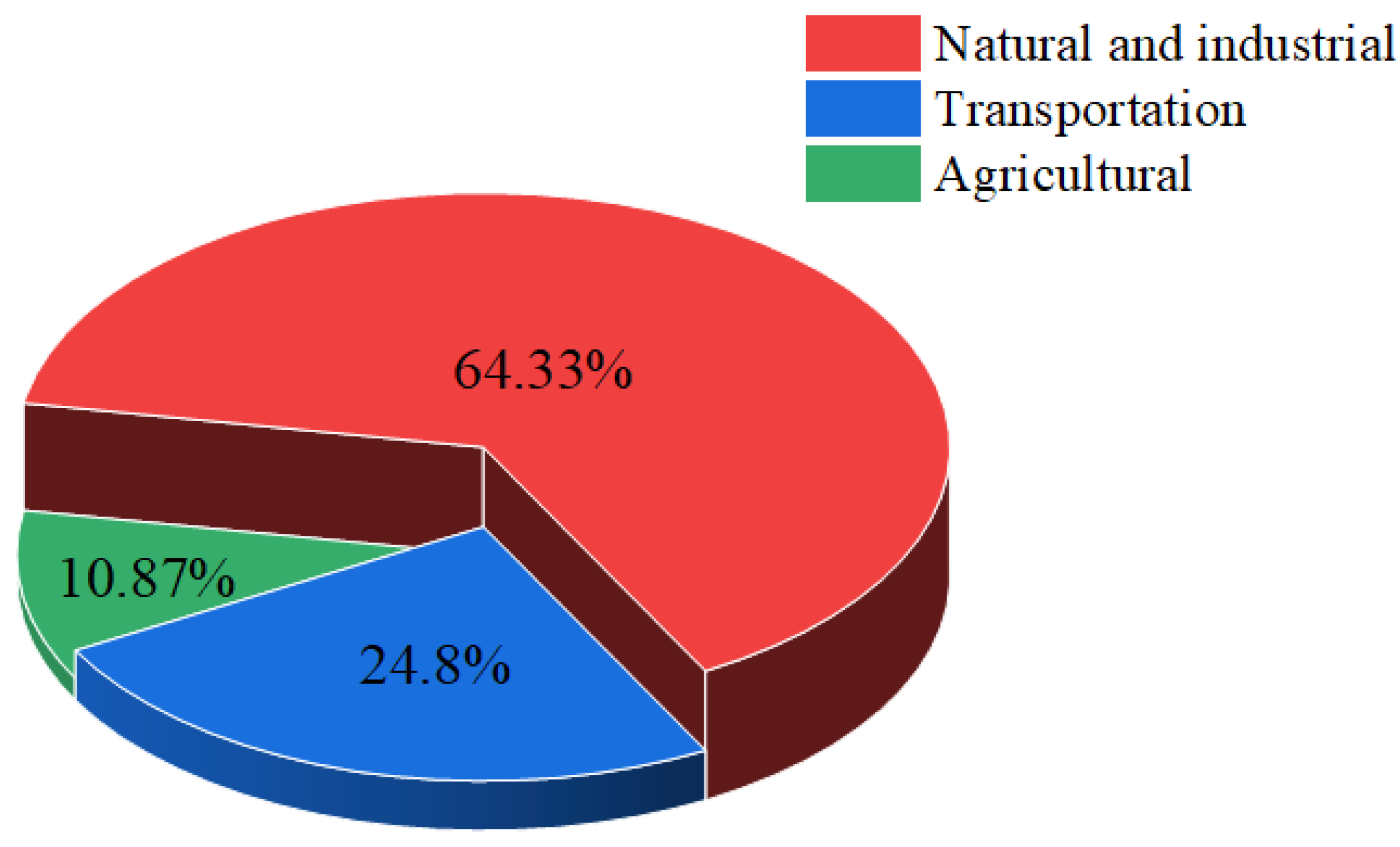
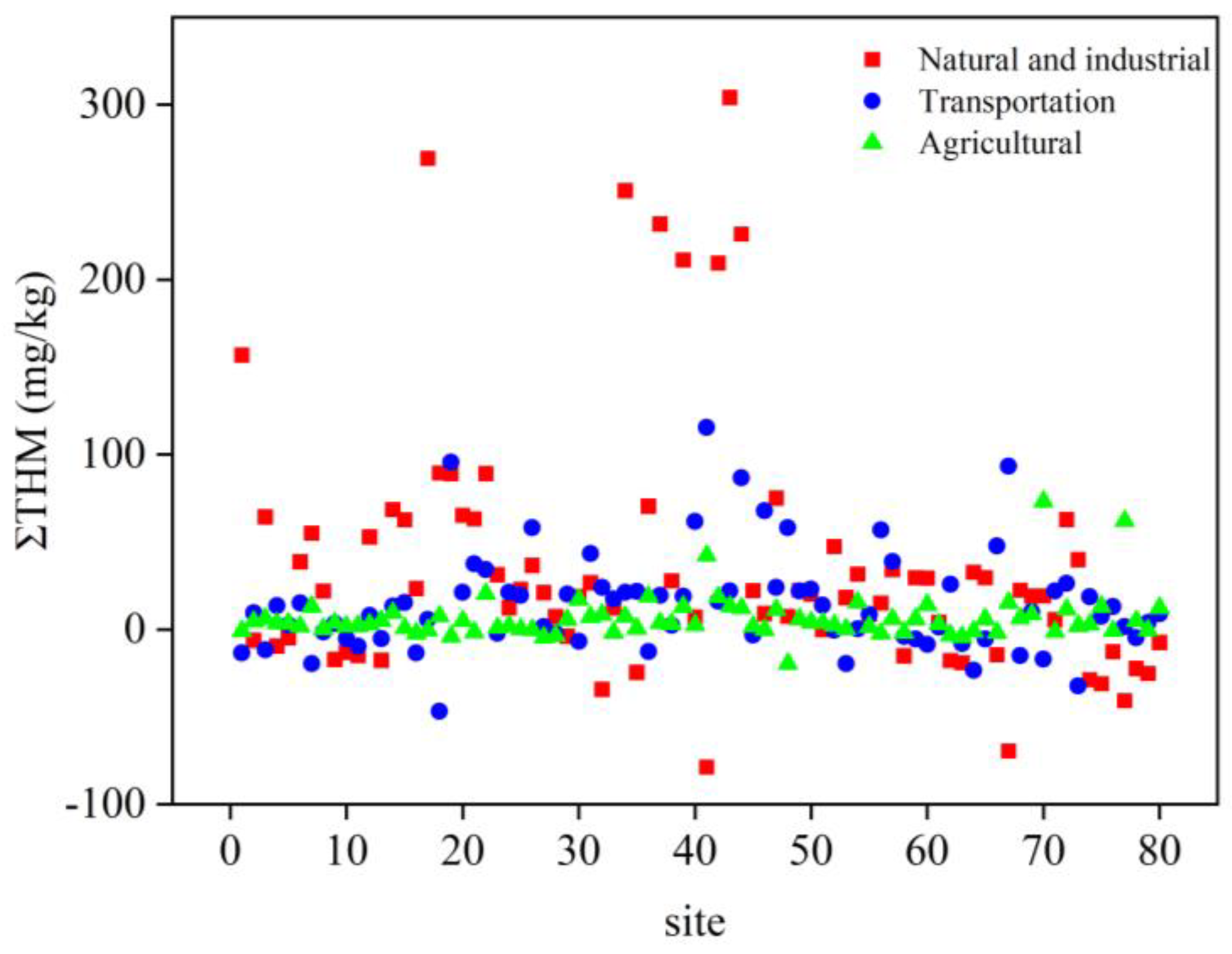
| HMs | Min | Max | Mean | SD | Skewness | Kurtosis | CV (%) | Background Value [25] |
|---|---|---|---|---|---|---|---|---|
| Cu | 1.00 | 72.00 | 16.45 | 15.71 | 1.79 | 3.00 | 0.96 | 17.0 |
| Pb | 3.00 | 235.00 | 40.20 | 35.72 | 3.23 | 14.07 | 0.89 | 36.0 |
| Zn | 8.50 | 169.00 | 45.10 | 32.28 | 1.47 | 2.16 | 0.72 | 47.3 |
| Cd | 0.0008 | 1.13 | 0.09 | 0.16 | 4.87 | 28.13 | 1.72 | 0.056 |
| Ni | 1.00 | 50.00 | 12.93 | 10.56 | 1.78 | 2.92 | 0.82 | 14.4 |
| Cr | 6.70 | 141.60 | 47.93 | 29.94 | 0.85 | 0.36 | 0.62 | 50.5 |
| Hg | 0.02 | 0.95 | 0.13 | 0.15 | 2.98 | 11.81 | 1.10 | 0.078 |
| As | 1.24 | 102.70 | 14.44 | 15.78 | 3.86 | 18.52 | 1.09 | 8.9 |
| Co | 0.42 | 26.00 | 5.68 | 5.24 | 1.81 | 3.44 | 0.92 | 7.0 |
| Mn | 21.00 | 1010.00 | 199.66 | 197.69 | 2.10 | 4.38 | 0.99 | 279 |
| pH | 4.2 | 8.3 | 5.24 | 0.80 | 1.54 | 2.67 | 0.15 | - |
Publisher’s Note: MDPI stays neutral with regard to jurisdictional claims in published maps and institutional affiliations. |
© 2021 by the authors. Licensee MDPI, Basel, Switzerland. This article is an open access article distributed under the terms and conditions of the Creative Commons Attribution (CC BY) license (https://creativecommons.org/licenses/by/4.0/).
Share and Cite
Yin, G.; Zhu, H.; Chen, Z.; Su, C.; He, Z.; Chen, X.; Qiu, J.; Wang, T. Spatial Distribution and Source Apportionment of Soil Heavy Metals in Pearl River Delta, China. Sustainability 2021, 13, 9651. https://doi.org/10.3390/su13179651
Yin G, Zhu H, Chen Z, Su C, He Z, Chen X, Qiu J, Wang T. Spatial Distribution and Source Apportionment of Soil Heavy Metals in Pearl River Delta, China. Sustainability. 2021; 13(17):9651. https://doi.org/10.3390/su13179651
Chicago/Turabian StyleYin, Guangcai, Hanghai Zhu, Zhiliang Chen, Chuanghong Su, Zechen He, Xinglin Chen, Jinrong Qiu, and Tieyu Wang. 2021. "Spatial Distribution and Source Apportionment of Soil Heavy Metals in Pearl River Delta, China" Sustainability 13, no. 17: 9651. https://doi.org/10.3390/su13179651
APA StyleYin, G., Zhu, H., Chen, Z., Su, C., He, Z., Chen, X., Qiu, J., & Wang, T. (2021). Spatial Distribution and Source Apportionment of Soil Heavy Metals in Pearl River Delta, China. Sustainability, 13(17), 9651. https://doi.org/10.3390/su13179651







